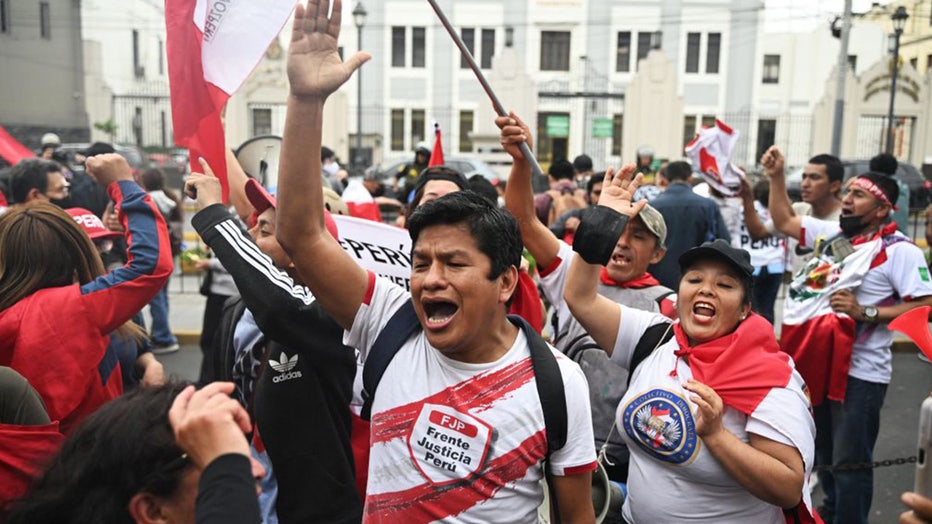Peru's president ousted by Congress amid political turmoil
FILE - President of the Peruvian Congress Jose Williams Zapata (L) swears in Dina Boluarte (R) as the new President hours after former President Pedro Castillo was impeached in Lima, on Dec. 7, 2022. (CRIS BOURONCLE/AFP via Getty Images)
LIMA, Peru - The president of Peru was ousted by Congress Wednesday after he sought to dissolve the legislative body and take unilateral control of the government, triggering a grave constitutional crisis.
Vice President Dina Boluarte replaced Pedro Castillo and became the first female leader in the history of the republic after hours of wrangling between the legislature and the president.
Boluarte, a 60--year-old lawyer, called for a political truce and the installation of a national unity government.
"What I ask for is a space, a time to rescue the country," she said.
Lawmakers voted 101-6 with 10 abstentions to remove Castillo from office for reasons of "permanent moral incapacity."
He left the presidential palace in an automobile that carried him through Lima’s historic downtown. He entered a police station, where his status was not immediately clear. In a photograph circulated by the national police on Twitter before it was erased, Castillo could be seen seated inside the station surrounded by officers.
Fluent in Spanish and Quechua, Boluarte was elected as vice president on the presidential ticket that brought Castillo to power July 28, 2021. During Castillo’s brief administration, Boluarte was minister of development and social inclusion.
Shortly before the vote, Castillo announced that he was installing a new emergency government and would rule by decree. He ordered a nightly curfew starting Wednesday night. The head of Peru's army then resigned, along with four ministers, including those over foreign affairs and the economy.
The Ombudsman's Office, an autonomous government institution, said before the congressional vote that Castillo should turn himself in to judicial authorities.
After years of democracy, Peru is in the midst of a constitutional collapse "that can't be called anything but a coup," the statement said.
International reaction was at times outpaced by events.
United States Amb. Lisa Kenna called on Castillo via Twitter to reverse his decree to dissolve Congress, saying the U.S. government rejected any "extra-constitutional" actions by the president to interfere with Congress.
A short time later the Congress voted to remove Castillo.
Mexico Foreign Affairs Secretary Marcelo Ebrard said via Twitter that given recent events in Peru, Mexico had decided to postpone the Pacific Alliance summit scheduled for Dec. 14 in Lima. He said he regretted the recent developments and called for democracy and human rights to be respected.
The administration of Chilean President Gabriel Boric lamented the political situation in Peru and trusted that the crisis would be resolved through democratic mechanisms. Spain's government strongly condemned the break in constitutional order and congratulated the country on righting itself democratically.
Castillo had said in an unusual midnight address on state television ahead of the vote that he would never stain "the good name of my honest and exemplary parents, who like millions of Peruvians, work every day to build honestly a future for their families."
The peasant-turned-president said he’s paying for mistakes made due to inexperience. But he said a certain sector of Congress "has as its only agenda item removing me from office because they never accepted the results of an election that you, my dear Peruvians, determined with your votes."
Castillo has denied allegations of corruption against him, saying they’re based on "hearsay statements by people who, seeking to lighten their own punishments for supposed crimes by abusing my confidence, are trying to involve me without evidence."
Federal prosecutors are investigating six cases against Castillo, most of them for alleged corruption, under the theory that he had used his power to profit from public works.
The power struggle in Perú’s capital has continued as the Andes and its thousands of small farms struggle to survive the worst drought in a half-century. Without rain, farmers can’t plant potatoes, and the dying grass can no longer sustain herds of sheep, alpacas, vicuñas and llamas. Making matters worse, avian flu has killed at least 18,000 sea birds and infected at least one poultry producer, endangering the chicken and turkeys raised for traditional holiday meals.

FILE - Opposers to Peruvian President Pedro Castillo protest outside the Lima Prefecture, where Castillo is alleged to be, in Lima, on Dec. 7, 2022. ( ERNESTO BENAVIDES/AFP via Getty Images)
The government also confirmed that in the past week, the country has suffered a fifth wave of COVID-19 infections. Since the beginning of the pandemic, 4.3 million Peruvians have been infected, and 217,000 of them have died.
The first president to come from a poor farming community in the nation’s history, Castillo arrived in the presidential palace last year without any political experience. He changed his cabinet five times during his year and a half in office, running through 60 different cabinet officials, leaving various government agencies paralyzed.
Although Castillo is the first president to be investigated while still in office, the probes are no surprise in a country where nearly every former president in the last 40 years have been charged with corruption linked to multinational corporations, such as the Brazilian construction firm Odebrecht.
Since 2016, Perú has been entrenched in political crises, with congresses and presidents trying to eliminate each other in turn. President Martín Vizcarra (2018-2020) dissolved Congress in 2019 and ordered new elections. That new legislature removed Vizcarra the next year. Then came President Manuel Merino, who lasted less than a week before a crackdown killed two protesters and injured 200 more. His successor, Francisco Sagasti, lasted nine months before Castillo took over.

